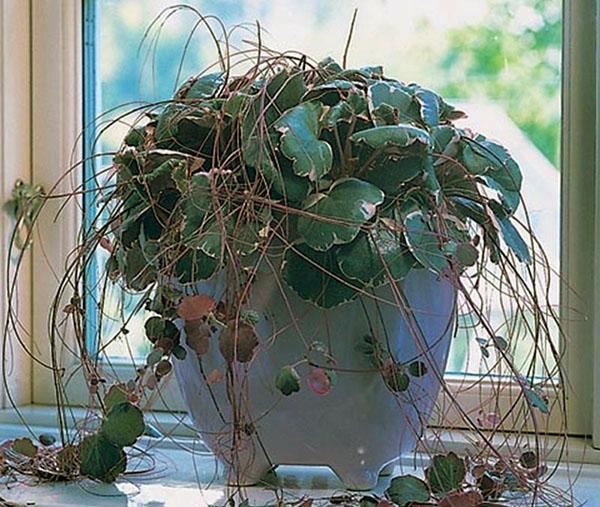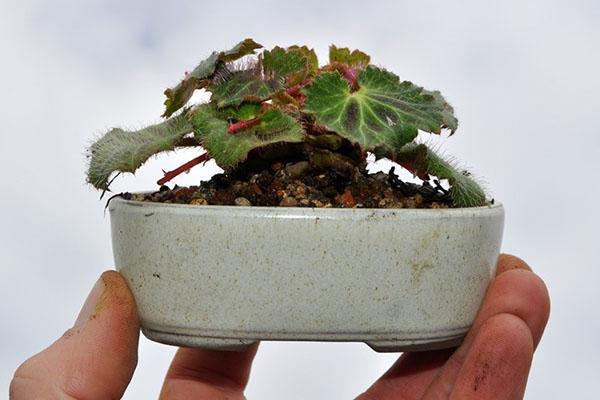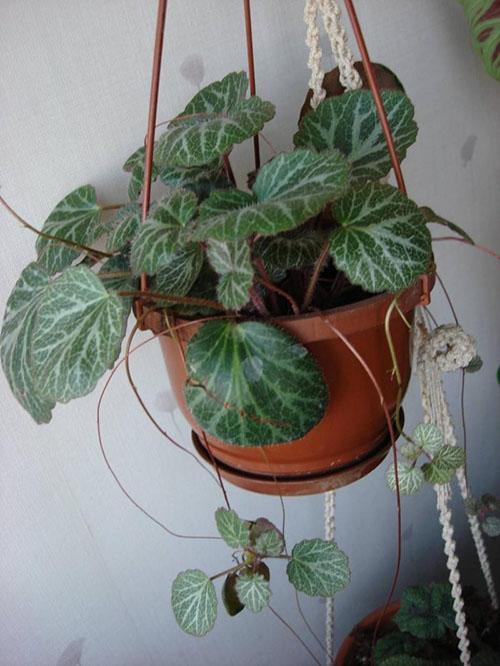Wonderful saxifrage at home
 Saxifrage at home is a beautiful and very useful plant. The flower differs not only in its attractiveness, but also in its ease of care. In order for the saxifrage to please with its appearance for a long time, you will need to follow a number of simple rules.
Saxifrage at home is a beautiful and very useful plant. The flower differs not only in its attractiveness, but also in its ease of care. In order for the saxifrage to please with its appearance for a long time, you will need to follow a number of simple rules.
Home care

Care after purchase
 When shopping for saxifrage at the store, choose pre-made, rooted rosettes.
When shopping for saxifrage at the store, choose pre-made, rooted rosettes.
You can provide the necessary drainage by simply pouring a layer of ordinary expanded clay on the bottom of the pot.
This plant is ideal for hanging planter... The only condition is that it must be isolated from batteries and heaters.
When transplanting a plant, do not forget about good drainage. Stagnant water promotes decay of the root system.
Lighting
 Indoor saxifrage flowers should be placed in rooms with windows facing north or west. Too much bright light will negatively affect hardwood slabs.
Indoor saxifrage flowers should be placed in rooms with windows facing north or west. Too much bright light will negatively affect hardwood slabs.
Pruning
 Cut off the saxifrage only when it fades. Cut off the old outlet and new leaves will grow in its place. To make the plant look aesthetically pleasing, do not forget to remove dry branches.
Cut off the saxifrage only when it fades. Cut off the old outlet and new leaves will grow in its place. To make the plant look aesthetically pleasing, do not forget to remove dry branches.
Watering
 This flower is watered only with soft water, which has settled well. From March to October, irrigate regularly (as soon as the soil surface dries out). In winter, more moderate watering is provided, only the earthen lump should not dry out.
This flower is watered only with soft water, which has settled well. From March to October, irrigate regularly (as soon as the soil surface dries out). In winter, more moderate watering is provided, only the earthen lump should not dry out.
Landing
Saxifrage can be planted all year round. Several sockets are placed simultaneously in a small wide pot. This will create a beautiful bush.
Caring for a saxifrage at home includes not only planting a plant, but also choosing a soil. The land should be taken rich in humus. It is such a substrate that will allow the culture to develop correctly.
The saxifrage is very fond of limestone. To provide this beauty with ideal conditions, add crushed limestone to the ground, or plant a saxifrage on the slope of a rock garden.
If you plan to plant the saxifrage outdoors, it is best to do so in the spring. Do not plant plants too close to each other. The most optimal distance between them is twenty centimeters.
Saxifrage at home: transplanting and feeding
 The saxifrage is transplanted as the roots grow, and not according to some strict schedule. When the roots are completely entwined with an earthen ball, and the pot becomes too tight for them, it's time to replant. If the procedure takes place during the flowering period, the peduncles are cut off. The new container should be shallow, and the soil should be humus, with an average acidity.
The saxifrage is transplanted as the roots grow, and not according to some strict schedule. When the roots are completely entwined with an earthen ball, and the pot becomes too tight for them, it's time to replant. If the procedure takes place during the flowering period, the peduncles are cut off. The new container should be shallow, and the soil should be humus, with an average acidity.
Be sure to make a hole in the bottom of the pot so that excess moisture can escape.
Gravel or expanded clay is used as drainage. The soil mixture can be as follows: peat with sand, humus, leaf and turf soil. All components are taken in equal parts. You can take a different proportion: mix the sand with turf, peat or humus (1: 1: 2).
 The flower needs fertilization. The first procedure is carried out 14 days after landing. Spring dressing is applied every two weeks, and then less often. From mid-autumn to the end of winter (approximately from October to February), the saxifrage is not fertilized with anything at all.Purchased liquid fertilizer is diluted in a very weak concentration (2 times less than indicated in the instructions). The plant responds well to superphosphate, complex fertilizers, as well as bone meal. But it is better not to use nitrogen-containing fertilizers. Shoots will grow chaotically to the detriment of flowering and decorativeness of the plant.
The flower needs fertilization. The first procedure is carried out 14 days after landing. Spring dressing is applied every two weeks, and then less often. From mid-autumn to the end of winter (approximately from October to February), the saxifrage is not fertilized with anything at all.Purchased liquid fertilizer is diluted in a very weak concentration (2 times less than indicated in the instructions). The plant responds well to superphosphate, complex fertilizers, as well as bone meal. But it is better not to use nitrogen-containing fertilizers. Shoots will grow chaotically to the detriment of flowering and decorativeness of the plant.
Reproduction of saxifrage at home
The saxifrage reproduces in three ways, and each of them has its own time. If you follow the recommendations, you can grow a very beautiful plant.
Seeds
 Planting material must be prepared for a long time for germination. Cold treatment begins in April. Wet soil is poured into a small container and seeds are spread on its surface. Next, this container is placed in the refrigerator for two to three weeks, and then transferred to a bright place. The first shoots should appear in a week, but provided that the room temperature is not less than + 18 ° - + 20 °.
Planting material must be prepared for a long time for germination. Cold treatment begins in April. Wet soil is poured into a small container and seeds are spread on its surface. Next, this container is placed in the refrigerator for two to three weeks, and then transferred to a bright place. The first shoots should appear in a week, but provided that the room temperature is not less than + 18 ° - + 20 °.
After the appearance of the second strong leaf, the seedlings dive into larger boxes. The distance between the plants should be at least 8-10 cm. When picking, it is important to ensure that the soil remains on the roots.
Cuttings
 This method is the most convenient. Within 9-10 months you will receive new plants. Cuttings are made in June or July and disembarked in spring. When the saxifrage finishes blooming, part of the pillow must be separated and divided into two rosettes (one centimeter each). The lower leaves are removed from the outlets and planted in the prepared soil. Provide shade and cover (film or glass) to keep the rooting process smooth.
This method is the most convenient. Within 9-10 months you will receive new plants. Cuttings are made in June or July and disembarked in spring. When the saxifrage finishes blooming, part of the pillow must be separated and divided into two rosettes (one centimeter each). The lower leaves are removed from the outlets and planted in the prepared soil. Provide shade and cover (film or glass) to keep the rooting process smooth.
The emergence of new lateral rosettes indicates successful rooting.
By dividing the bush
 Another fairly easy breeding method. Wait for the end of flowering. The number of outlets on adult flowers should be more than three. Only healthy specimens are subject to division. Select the bushes you like and water them well. The shoots from the adult flower are separated together with the roots and leaves using a sharp knife, and together with additional rosettes are transplanted into a new flowerpot. The soil around them should be watered periodically.
Another fairly easy breeding method. Wait for the end of flowering. The number of outlets on adult flowers should be more than three. Only healthy specimens are subject to division. Select the bushes you like and water them well. The shoots from the adult flower are separated together with the roots and leaves using a sharp knife, and together with additional rosettes are transplanted into a new flowerpot. The soil around them should be watered periodically.
Growing problems
 The most common difficulties are spider mites and fungal diseases (powdery mildew). Copper-containing preparations will help to effectively cope with them.
The most common difficulties are spider mites and fungal diseases (powdery mildew). Copper-containing preparations will help to effectively cope with them.
High temperatures and too humid air are the best breeding grounds for pests.
The worms are easy to destroy by hand, and the plant itself must be treated with anti-coccid drugs. "Pirimor" will help against green aphids. Root rot is the most dangerous. It is practically not displayed. The solution to this problem requires radical measures - healthy cuttings are separated from the diseased plant, which are then planted. Usually, the problems arising during the cultivation of saxifrage are easy to solve, it is enough to eliminate their causes.
Knowing how to care for saxifrage wicker at home, you can grow an unusually beautiful plant that will decorate the room for many years.